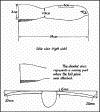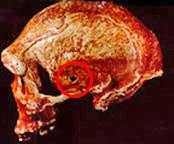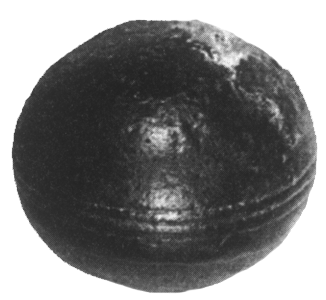| A testimony to ancient metallurgical skills in Delhi, India is called the Ashoka Pillar. Standing over 23 feet, it averages 16 inches in diameter and weighs about 6 tons. The solid wrought-iron shaft is made up of expertly welded discs. An inscription on the base is an epitaph to King Chandra Gupta II, who died in A.D. 413. Despite being well over a millennium and a half in age, the Pillar's constitution is remarkably preserved. The smooth surface is like polished brass with only occasional instances of pock-marks and weathering. The mystery is that any equivalent mass of iron, subjected to the Indian monsoon rains, winds and temperatures for 1,600 years or more would have been reduced to rust long ago. Production of the iron and the techniques of preservation are far beyond 5th century abilities. It is probably far older, maybe several thousand years. Who were the mysterious metallurgists who made this wonder, and what happened to their civilization? |  |
3. FLIGHT IN ANCIENT EGYPT
 In 1898 a curious winged object was discovered in the tomb of Pa-di-Imen in north Saqqara, Egypt dated to about 200 B.C. Because the birth of modern aviation was still several years away, when the strange artifact was sent to the Cairo Museum, it was catalogued and then shelved among other miscellaneous items to gather dust.
In 1898 a curious winged object was discovered in the tomb of Pa-di-Imen in north Saqqara, Egypt dated to about 200 B.C. Because the birth of modern aviation was still several years away, when the strange artifact was sent to the Cairo Museum, it was catalogued and then shelved among other miscellaneous items to gather dust. Seventy years later, Dr. Khalil Messiha, an Egyptologist and archaeologist, was examining a Museum display labeled bird figurines. While most of the display were indeed bird sculptures,
 |
 |
 |
Made of very light sycamore the craft weighs 0.5 oz. with straight and aerodynamically shaped wings, spanning about 7 inches. A separate slotted piece fits onto the tail precisely like the back tail wing on a modern plane.
A full-scale version could have flown carrying heavy loads, but at low speeds, between 45 and 65 miles per hour. What is not known, however, is what the power source was. The model makes a perfect glider as it is. Even though over 2,000 years old, it will soar a considerable distance with only a slight jerk of the hand. Fully restored balsa replicas travel even farther.
Messiha notes that the ancient Egyptians often built scale models of everything familiar in their daily lives and placed them in their tombs, temples, ships, chariots, servants, animals and so forth.
Now that we have found a model plane, Messiha wonders if perhaps somewhere under the desert sands there may yet be unearthed the remains of life-sized gliders.
4. A JET FROM SOUTH AMERICA
In 1954 the government of Colombia sent part of its collection of ancient gold artifacts on a U. S. tour. Emmanuel Staubs, one of America's leading jewelers, was commissioned to cast reproductions of six of the objects. Fifteen years later one was given to biologist-zoologist Ivan T. Sanderson for analysis. After a thorough examination and consulting a number of experts, Sanderson's mind-boggling conclusion was that the object is a model of a high-speed aircraft at least a thousand years old.
Approximately 2 inches long the object was worn as a pendant on a neck chain. It was classified as Sinu, a pre-Inca culture from A.D. 500 to 800. Both Sanderson and Dr. Arthur Poyslee of the Aeronautical Institute of New York concluded it did not represent any known winged animal. In fact, the little artifact appears more mechanical than biological. For example, the front wings are delta-shaped and rigidly straight edged, very un-animal-like.
The rudder is perhaps the most un-animal but airplane-like item. It is right-triangle, flat-surfaced, and rigidly perpendicular to the wings. Only fish have upright tail fins, but none have exclusively an upright flange without a counter-balancing lower one. Adding to the mystery, an insignia appears on the left face of the rudder, precisely where ID marks appear on many airplanes today. The insignia is perhaps as out-of place as the gold model itself, for it has been identified as the Aramaic or early Hebrew letter beth or B.
This may indicate that the original plane did not come from Colombia, but was the product of a very early people inhabiting the Middle East who knew the secret of flying.
5. CRYSTAL SKULL FROM ATLANTIS
Without doubt the most famous and enigmatic ancient crystal is the skull, discovered in 1927 by F.A. Mitchell-Hedges atop a ruined temple at the ancient Mayan city of Lubaantum, in British Honduras, now Belize.
The skull was made from a single block of clear quartz, 5 inches high, 7 inches long and 5 inches wide. It is about the size of a small human cranium, with near perfect detail. In 1970, art restorer Frank Dorland was given permission to submit the skull to tests at the Hewlitt-Packard Laboratories. Revealed were many anomalies.
The skull had been carved with total disregard to the natural crystal axis, a process unheard-of in modern crystallography. No metal tools were used. Dorland was unable to find any tell-tale scratch marks. Indeed, most metals would have been ineffectual. A modern penknife cannot mark it. From tiny patterns near the carved surfaces, Dorland determined it was first chiseled into rough form, probably using diamonds. The finer shaping, grinding and polishing, Dorland believes, was done with innumerable applications of water and silicon-crystal sand. If true, it would have taken 300 years of continuous labor. We must accept this almost unimaginable feat, or admit to the use of some form of lost technology.
Modern science is stumped to explain the skill and knowledge incorporated. As Garvin summarized: It is virtually impossible today, in the time when men have climbed mountains on the moon, to duplicate this achievement...It would not be a question of skill, patience and time. It would simply be impossible.
6. WHO SHOT THE NEANDERTHAL MAN?
The Museum of Natural History in London displays an early Paleolithic skull, dated at 38,000 years old, and excavated in 1921 in modern Zambia. On the left side of the skull is a perfectly round hole nearly a third of an inch in diameter. Curiously, there are no radial split-lines around the hole or other marks that should have been left by a cold weapon, such as an arrow or spear. Opposite the hole, the cranium is shattered, and reconstruction of the fragments show the skull was
 blown from the inside out, as from a rifle shot. In fact, any slower a projectile would have produced neither the neat hole nor the shattering effect.
blown from the inside out, as from a rifle shot. In fact, any slower a projectile would have produced neither the neat hole nor the shattering effect. Forensic experts who have examined the skull agree the cranial damage could not have been caused by anything but a high-speed projectile, purposely fired at the prehistoric victim, with intent to kill.
If such a weapon was indeed fired at the man, then one of two conclusions can be made: Either the specimen is not as old as it is claimed to be, and was shot by a European in recent centuries, or the remains are as old as claimed, and the marksman was ancient too. In view of the fact that the Paleolithic skull was excavated from a depth of 60 feet, mostly of lead rock, the second conclusion is more plausible.
But who possessed gunpowder 38,000 years ago? Certainly not Stone Age man himself. Another race must have existed, one far more advanced and civilized, yet contemporary.
7. THE INCREDIBLE STONE OF DR. CABRERA
A very unique time-capsule of images is housed in a warehouse in Ica, Peru. Here are some 20,000 stone boulders, tablets, and baseball-sized rocks, decorated with an astounding assortment of pictures, in many cases very much out of time and place. The owner is local physician, amateur archeologist and geologist Dr. Javier Cabrera Darquea.
Most material employed is a gray andesite, an extremely hard granitic semi-crystalline matrix, that is very difficult to carve. But as Dr. Cabrera observed, People have been finding these engraved stones in the region for years. They were first seen and recorded by Jesuit missionary Father Simon, who accompanied Pizarro in 1525. Samples were shipped to Spain in 1562.
The stone portraits show very sophisticated surgery skills and medical knowledge, in some cases as advanced, and even more advanced, than today. There are scenes of Caesarean sections, blood transfusions, the use of acupuncture needles as an anesthetic (which only gained use in the West since the late 1970s), delicate operations on the lungs and kidneys, and removal of cancerous tumors. There are likewise detailed images of open heart and open brain surgery, as well as 20 stones showing a step-by-step heart transplant procedure.
This is a disturbing revelation in itself, that someone in unknown antiquity achieved a level of sophistication rivaling our own. But there are other pictures even more out-of-place. As Dr. Cabrera noted, and as has been verified by other medical physicians, there are stone etchings which show a brain transplant.
The prehistoric surgeons, it is evident, possessed knowledge several steps beyond modern-day surgery.
8. MANUFACTURED METALS MILLIONS OF YEARS OLD
For the past three decades miners at the Wonderstone Silver Mine near Ottosdal in the Western Transvaal, South Africa,
 have been extracting out of deep rock several strange metallic spheroids. So far at least 200 have been found. In 1979, several were closely examined by J.R. McIver, professor of geology at the University of Witwaterstand in Johannesburg, and geologist professor Andries Bisschoff of Potsshefstroom University.
have been extracting out of deep rock several strange metallic spheroids. So far at least 200 have been found. In 1979, several were closely examined by J.R. McIver, professor of geology at the University of Witwaterstand in Johannesburg, and geologist professor Andries Bisschoff of Potsshefstroom University. The metallic spheroids look like flattened globes, averaging 1 to 4 inches in diameter, and their exteriors usually are colored steel blue with a reddish reflection, and embedded in the metal are tiny flecks of white fibers. They are made of a nickel-steel alloy which does not occur naturally, and is of a composition that rules them out, being of meteoric origin. Some have only a thin shell about a quarter of an inch thick, and when broken open are found filled with a strange spongy material that disintegrated into dust on contact with the air.
What makes all this very remarkable is that the spheroids were mined out of a layer of pyrophyllite rock, dated both geologically and by the various radio-isotope dating techniques as being at least 2.8 to 3 billion years old.
Adding mystery to mystery, Roelf Marx, curator of the South African Klerksdorp Museum, has discovered that the spheroid he has on exhibit slowly rotates on its axis by its own power, while locked in its display case and free of outside vibrations.
Source-www.bibliotecapleyades.net



